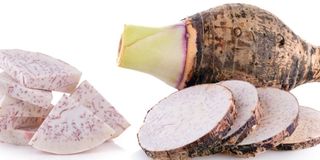Reasons to eat more taro root

Taro root is easily available at affordable prices. PHOTO/misterproduce.com
What you need to know:
Due to its high fibre and starch content, taro root may make you feel full for longer, thus reducing your overall calorie intake leading to weight loss and reduced body fat.
Taro root (ejuuni) is usually light purple in colour and while it is usually steamed, it can also be mashed to create a thick soup.
Fibre
Innocent Kwame, a nutritionist, says taro root is rich in fibre, which helps reduce the risk of developing cardiovascular disease. “Fibre also makes digestion easier, hence helping one avoid poor bowel movement,” he shares.
The abundance of fibre and carbohydrates also translates into consuming less taro root.
“This means that one gets satisfied without eating too much thus balanced blood sugar levels. Taro root also digests slowly and, therefore, does not cause any unnecessary fluctuations in blood sugar levels. This makes it a suitable food for persons with diabetes,” Kwame shares.
Rich in antioxidants
Taro root is filled with antioxidants such as beta-carotene which help in reducing free radicals in the body. “A combination of Vitamin C and antioxidants protects body cells from the effects of free radicals such as cancer and heart disease,” Kwame says.
Vitamin C
These tubers have an ample supply of Vitamin C, which the body cannot produce but needs for various purposes. “Some of the purposes of Vitamin C include keeping flu and colds at bay while facilitating quick wound healing. Additionally, it stimulates collagen production which improves skin elasticity, and repairs damaged skin,” Fatima Nshuti, a beautician, shares.
Improving neonatal health
The folate in taro root helps foetal brain development, the reason it is a great addition to a pregnant woman’s diet.
Vitamin B supply
Taro root provides the body with Vitamin B which Ignatius Nsereko, a nutritionist, says helps in improving our nervous system health.
“They help in improving one’s learning capabilities and memory. Additionally, the vitamin is said to lower the risk of developing cardiovascular diseases,” he shares.
Improved endocrine system health
A number of women in menopause undergo hormone replacement therapy. However, according to experts, taro root contains an enzyme that acts as a natural alternative. “Taro root also contains Vitamin B6 which helps in guarding against depression-induced Premenstrual Syndrome,” Nsereko says.
Rich in minerals
Taro root contains several minerals such as copper, potassium, iron, magnesium, calcium, and phosphorus, which offer various health benefits.
“For example, potassium is great at increasing blood flow to the brain while also improving neural activity, concentration, and cognitive abilities.
Improved sight
The Vitamin A in taro root, which is converted into beta-carotene is responsible for keeping the mucous membranes in our eyes healthy.
“This is crucial for easy eyeball movement devoid of friction. Moreover, night vision deficiency is solved and vision problems related to aging are reduced when one consumes taro root,” Nsereko shares.
Complex carbohydrates
While carbohydrates are looked at as weight gain agents, they are an important part of our diet as it is from these that we get glucose, our source of energy.
Gluten-free
The tuber is free of gluten, which is great news for people who are allergic to gluten. “This makes taro root a great alternative to wheat flour since it can easily be mashed after cooking to either thicken soup or for baking,” Nsereko shares.
Note
Unlike sweet potatoes which can be eaten raw, taro root should never be consumed uncooked since it carries naturally-occurring plant toxins including dioscorine, diosgenin, and triterpenes. The tuber must be peeled and cooked in order to remove these bitter proteins.





